Monthly Updates on Recent Books in the History of Christianity
Due to the cancellation of many conferences in the past months amid the COVID-19 pandemic, many of us have had less opportunity to browse or even see new books coming out in our fields. To raise awareness of recent books in the history of Christianity, the editorial staff of Church History: Studies in Christianity and Culture highlights each month a list of 10-15 books in diverse periods and geographical regions that we hope will be of interest to our members. We include here below the third monthly list, chosen by our staff, with excerpts from the publishers’ blurbs.
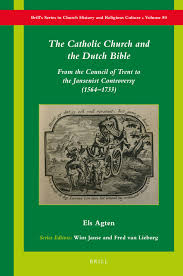
Els Agten, The Catholic Church and the Dutch Bible: From the Council of Trent to the Jansenist Controversy (1564-1733). 2020
In The Catholic Church and the Bible: From the Council of Trent to the Jansenist Controversy (1564-1733), Els Agten studies the impact of Jansenism and anti-Jansenism on the ideas regarding vernacular Bible reading and Bible production in the Low Countries in the sixteenth and seventeenth centuries. The book provides a review of book censorship during this time.
Furthermore, it analyses the ideas and the writings of ten protagonists, including theologians, Bible translators, ecclesiastical authorities and representatives of Port-Royal. In particular, the author demonstrates how, even as their opponents took a more cautious position, the Jansenists
encouraged the laity, including women and children, to read the Bible without any restrictions.
See publisher's website.
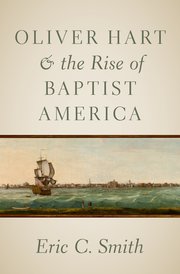
Eric C. Smith, Oliver Hart and the Rise of Baptist America. 2020
Baptists in America began the eighteenth century a small, scattered, often harassed sect in a vast sea of religious options. By the early nineteenth century, they were a unified, powerful, and rapidly-growing denomination, poised to send missionaries to the other side of the world. One of the most influential yet neglected leaders in that transformation was Oliver Hart, longtime pastor of the Charleston Baptist Church. Oliver Hart and the Rise of Baptist America is the first modern biography of Hart, arguably the most important evangelical leader in the pre-Revolutionary South.
During his thirty years in Charleston, Hart emerged as the region's most important Baptist denominational architect. His outspoken patriotism forced him to flee Charleston when the British army invaded Charleston in 1780, but he left behind a southern Baptist people forever changed by his energetic ministry. Hart's accommodating stance toward slavery enabled him and the white Baptists who followed him to reach the center of southern society, but also eventually doomed the national Baptist denomination of Hart's dreams.
More than a biography, Oliver Hart and the Rise of Baptist America seamlessly intertwines Hart's story with that of eighteenth-century American Baptists, providing one of the most thorough accounts to date of this important and understudied religious group's development. This book makes a significant contribution to the study of Baptist life and evangelicalism in the pre-Revolutionary South and beyond.
See publisher's website.

Sebastian Brock, Singer of the Word of God: Ephrem the Syrian and his Significance in Late Antiquity. 2020
As the first volume of the Sebastianyotho series, this book collects Sebastian P. Brock’s articles related to Ephrem the Syrian. Many of the articles have been updated and some are published in English for the first time alongside a number of previously published works. The articles cover a wide array of topics, including a biographical overview of the saint, an exposition of St. Ephrem’s importance for Christianity today and his relevance as a theologian, an analysis of some of his works, and a bibliographic guide to editions of these works.
See publisher's website.
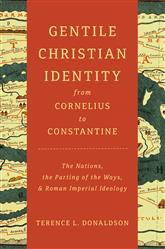
Terence L. Donaldson, Gentile Christian Identity from Cornelius to Constantine: The Nations, the Parting of Ways and Roman Imperial Ideology. 2020
Originally an ascribed identity that cast non-Jewish Christ-believers as an ethnic other, “gentile” soon evolved into a much more complex aspect of early Christian identity. Gentile Christian Identity from Cornelius to Constantine is a full historical account of this trajectory, showing how, in the context of “the parting of the ways,” the early church increasingly identified itself as a distinctly gentile and anti-Judaic entity, even as it also crafted itself as an alternative to the cosmopolitan project of the Roman Empire. This process of identity construction shaped Christianity’s legacy, paradoxically establishing it as both a counter-empire and a mimicker of Rome’s imperial ideology.
Drawing on social identity theory and competitive ethnography, Terence Donaldson offers an analysis of gentile Christianity that is thorough and highly relevant to today’s discourses surrounding identity, ethnicity, and Christian-Jewish relations. As Donaldson shows, a full understanding of the term gentile is key to understanding the modern Western world and the church as we know it.
See publisher's website.
![]()
Ivan Gerát, Iconology of Charity: Medieval Legends of Saint Elizabeth in Central Europe. 2020
The images analyzed in this book give each viewer the possibility to interact with Saint Elizabeth’s unique spiritual way, which was nurtured by various sources, including moments of spontaneous inspiration. The religious leaders who went on to imagine and commission a visual image understood the enormous potential associated with the religious zeal of the extraordinary noble lady as a shining example offering new paths towards Christian charity. The images represent an important testimony of what happened, or rather how the artist or the patron imagined events from the saint´s life.
Elizabeth’s extraordinary individual charity has been a source of inspiration to many of her admirers, but the artists and their patrons must have experienced and considered the needs and desires which characterized their period and the communities they were serving. There has been a significant interval between the over-temporal needs or values and contingent historical situations with changing constellations of interests, medial landscapes and rules of political game. The medieval cult of saint Elizabeth awakened the interest of the most influential political figures of the time. Their individual dialogues with the saint connected resonant spiritual messages, which were valid for the duration of any individual’s lifespan, with transient concerns about political struggles, military fights, or materialistic considerations. As a result, the images are multilayered products reflecting human needs and longings on several levels. This book offers a minuscule testimony from this endless flux of feelings, observations and meditations in an effort to broaden slightly the limited range of human experience.
See publisher's website.
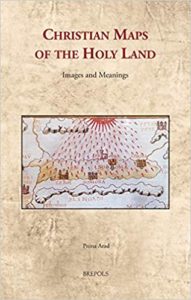
Pnina Arad, Christian Maps of the Holy Land: Images and Meaning. 2020
This book offers a way of reading maps of the Holy Land as visual imagery with religious connotations. Through a corpus of representative examples created between the sixth and the nineteenth centuries, it studies the maps as iconic imagery of an iconic landscape and analyses their strategies to manifest the spiritual quality of the biblical topography, to support religious tenets, and to construct and preserve cultural memory.
Maps of the Holy Land have thus far been studied with methodologies such as cartography and historical geography, while the main question addressed was the reliability of the maps as cartographic documents. Through another perspective and using the methodology of visual studies, this book reveals that maps of the Holy Land constructed religious messages and were significant instruments through which different Christian cultures (Byzantine, Catholic, Protestant, and Greek Orthodox) shaped their religious identities. It does not seek to ascertain how the maps delivered geographical information, but rather how they utilized the geographical information in formulating religious and cultural values.
Through its examination of maps of the Holy Land, this book thus explores both Christian visual culture and Christian spirituality throughout the centuries.
See publisher's website.

Ian Hugh Clary, Reformed Evangelicalism and the Search for a Usable Past: The Historiography of Arnold Dallimore, Pastor-Historian. 2020
The question of how theology shapes a Christian historian’s reading of the past has been debated thoroughly in various academic periodicals. Arnold Dallimore, who trained and specialised in pastoral ministry in Canada, wrote an influential biography of the revivalist George Whitefield, as well as others on Charles and Susanna Wesley, Edward Irving, and Charles Spurgeon.? While other books look at Christian historiography using abstract and methodological approaches, this book examines the subject precisely by looking at the life and work of an individual historian. It does so by placing Dallimore in the context of being a minister in twentieth-century Canada as well as his role in the development of Reformed Theology in the Anglosphere. It also examines the quality of his various biographies focusing on key issues such as the nature of religious revival, the problem of Christianity and slavery, and the question of charismatic religious experience. His study concludes by examining the relationship between the discipline and profession of church history and asking what is required for one to be considered a church historian.
See publisher's website.
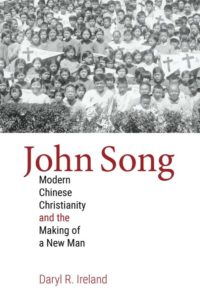
Daryl R. Ireland, John Song: Modern Chinese Christianity and the Making of a New Many. 2020
Dubbed the Billy Sunday of China for the staggering number of people he led to Christ, John Song has captured the imagination of generations of readers. His story, as it became popular in the West, possessed memorable, if not necessarily true, elements: Song was converted while he studied in New York at Union Theological Seminary in 1927, but his modernist professors placed him in an insane asylum because of his fundamentalism; upon his release, he returned to China and drew enormous crowds as he introduced hundreds of thousands of people to the Old-Time Religion.
In John Song: Modern Chinese Christianity and the Making of a New Man, Daryl Ireland upends conventional images of John Song and theologically conservative Chinese Christianity. Working with never before used sources, this groundbreaking book paints the picture of a man who struggled alongside his Chinese contemporaries to find a way to save their nation. Unlike reformers who attempted to update ancient traditions, and revolutionaries who tried to escape the past altogether, Song hammered out the contours of a modern Chinese life in the furnace of his revivals. Ireland reveals how Song ingeniously reformulated the Christian faith so that it was transformative and transferrable throughout China and Southeast Asia. It created new men and women who thrived in the region's newly globalized cities.
See publisher's website.
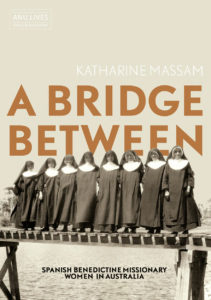
Katherine Massam, A Bridge Between: Catholic Benedictine Missionary Women in Australia. 2020
Australian National University Press
A Bridge Between is the first account of the Benedictine women who worked at New Norcia and the first book-length exploration of twentieth-century life in the Western Australian mission town. From the founding of a grand school intended for ‘nativas’, through links to Mexico and Paraguay then Ireland, India and Belgium, as well as to their house in the Kimberley, and a network of villages near Burgos in the north of Spain, this is a complex international history. A Bridge Between gathers a powerful, fragmented story from the margins of the archive, recalling the Aboriginal women who joined the community in the 1950s and the compelling reunion of missionaries and former students in 2001. By tracing the all-but-forgotten story of the community of Benedictine women who were central to the experience of the mission for many Aboriginal families in the twentieth century, this book lays a foundation for further work.
See publisher's website.

Bernice M. Kaczynski, The Oxford Handbook of Christian Monasticism. 2020
The Handbook takes as its subject the complex phenomenon of Christian monasticism. It addresses, for the first time in one volume, the multiple strands of Christian monastic practice. Forty-four essays consider historical and thematic aspects of the Catholic, Eastern Orthodox, Oriental Orthodox, Protestant, and Anglican traditions, as well as contemporary 'new monasticism'. The essays in the book span a period of nearly two thousand years--from late ancient times, through the medieval and early modern eras, on to the present day. The intention of the Handbook is to provide a balance of some essential historical coverage with a representative sample of current thinking on monasticism. The authors are a diverse and international group, who bring a wide range of critical perspectives to bear on pertinent themes and issues. They indicate developing trends in their areas of specialisation. The individual contributions, and the volume as a whole, set out an agenda for the future direction of monastic studies. In today's world, where there is increasing interest in all world monasticisms, where scholars are adopting more capacious, global approaches to their investigations, and where monks and nuns are casting a fresh eye on their ancient traditions, this publication is especially timely.
See publisher's website.

Ruben Suykerbuyk, The Matter of Piety: Zoutleeuw's Church of Saint Leonard and Religious Material Culture in the Low Countries (c. 1450-1620). 2020
The Matter of Piety provides the first in-depth study of Zoutleeuw’s exceptionally well-preserved pilgrimage church in a comparative perspective, and revaluates religious art and material culture in Netherlandish piety from the late Middle Ages through the crisis of iconoclasm and the Reformation to Catholic restoration. Analyzing the changing functions, outlooks, and meanings of devotional objects – monumental sacrament houses, cult statues and altarpieces, and small votive offerings or relics – Ruben Suykerbuyk revises dominant narratives about Catholic culture and patronage in the Low Countries. Rather than being a paralyzing force, the Reformation incited engaged counterinitiatives, and the vitality of late medieval devotion served as the fertile ground from which the Counter-Reformation organically grew under Protestant impulses.
See publisher's website.
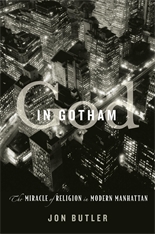
Jon Butler, God in Gotham: The Miracle of Religion in Modern Manhattan. 2020
In Gilded Age Manhattan, Catholic, Jewish, and Protestant leaders agonized over the fate of traditional religious practice amid chaotic and multiplying pluralism. Massive immigration, the anonymity of urban life, and modernity’s rationalism, bureaucratization, and professionalization
seemingly eviscerated the sense of religious community.
Yet fears of religion’s demise were dramatically overblown. Jon Butler finds a spiritual hothouse in the supposed capital of American secularism. By the 1950s Manhattan was full of the sacred. Catholics, Jews, and Protestants peppered the borough with sanctuaries great and small. Manhattan became a center of religious publishing and broadcasting and was home to august spiritual reformers from Reinhold Niebuhr to Abraham Heschel, Dorothy Day, and Norman Vincent Peale. A host of white nontraditional groups met in midtown hotels, while black worshippers gathered in Harlem’s storefront churches. Though denied the ministry almost everywhere, women shaped the lived religion of congregations, founded missionary societies, and, in organizations such as the Zionist Hadassah, fused spirituality and political activism. And
after 1945, when Manhattan’s young families rushed to New Jersey and Long Island’s booming suburbs, they recreated the religious institutions that had shaped their youth.
God in Gotham portrays a city where people of faith engaged modernity rather than foundered in it. Far from the world of “disenchantment” that sociologist Max Weber bemoaned, modern Manhattan actually birthed an urban spiritual landscape of unparalleled breadth, suggesting that modernity enabled rather than crippled religion in America well into the 1960s.
See publisher's website.
Finally, for staying up-to-date on the latest titles in all fields, we recommend regularly perusing New Books Network, and will regularly link to its “New Books in Christian Studies” page here. These pages are updated regularly.
